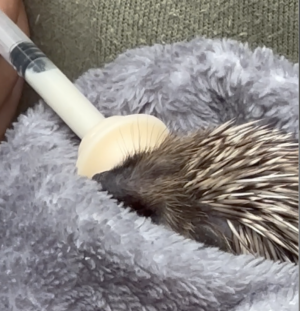How I killed a hedgehog

If a hedgehog is in distress it may just need water or you might want to seek help from an expert such as Lisa Steward of the Thorne Hedgehog Rescue project in Puckley, Kent. I met Lisa at Kent's Belmont Wood Fair in early September where she was bottle-feeding a hoglet whose mother had been run over by a car. This was only one of the 200 hedgehogs she has rescued and is nursing back to health. Another one that she is nursing had almost been decapitated by a strimmer but fortunately its wound had not become infected. What Lisa never does is to feed them cow's milk which can be fatal. Unfortunately I didn't know that when I found a distressed hedgehog a few years ago. My mistake of giving it a saucer of cow's milk may have killed it or it could already have been doomed from eating the neighbour's poisonous slug pellets. I'll always have that hedgehog on my conscience.
It turns out that hedgehogs are both loveable and important - they eat slugs and beetles and are an important part of the British ecosystem. Unfortunately they are often harmed by poisons such as insecticides and other chemicals: to reduce the chemical threat it has been illegal in the UK since 2022 to use or sell metaldehyde slug pellets, but many other threats remain. Cars can run them over partly because of the hedgehog's instinct to respond to danger by curling into a ball rather than running away - the paradox of roadkill is that if you don't see dead hedgehogs it does not mean they are all safe - more likely it means there are none, or very few, surviving in that vicinity. Another danger is that they get trapped - ponds with steep sides, swimming pools and cattle grids each represent a threat, so ideally each of these will have a ramp that the hedgehogs can use to climb out.
The British Hedgehog Preservation Society advise on how to help protect hedgehogs and they suggest that gardeners who light bonfires should be alert to the risk of unintended cremation of living hedgehogs. Unfortunately they are attracted to the sort of material that will be burnt in a bonfire such as dry leaves and twigs. So as a precaution, and if possible, a gardener should set up a new site for their fire and move the material across to that spot just before lighting the fire. Similarly anyone strimming an area should first check that there are no hedgehogs hiding in the uncut undergrowth.
Hedgehogs can also get trapped in litter or stuck in netting so it is sensible to make gardens hedgehog-safe. But it is even better to actively make gardens hedgehog friendly - by creating wild areas which offer shelter and natural food. And it helps to leave gaps below fences or ground-level holes in walls so that a garden is accessible to hedgehogs. Our enthusiasm for hedgehogs in the autumn should not be extended to translocating them from other places because they may have a dependent litter which is left behind and is then condemned to starvation. Indeed in the autumn hoglets need to grow rapidly so that they can survive their first winter of hibernation - at a minimum they need to weigh at least a pound or about half a kilogram.
You could help your hedgehogs by building a "hedgehog hotel" as Steve has done here with his daughter. Here is a short film by WoodlandsTV:
If you come across an injured hedgehog you could contact the British Hedgehog Preservation Society which keeps a Directory of local rescuers or "rehabilitators"
Comments are closed for this post.

Hedgehogs don’t eat slugs!
https://hedgehogcabin.info:
Hedgehogs are insectivores and their diet consists of caterpillars, beetles, grubs and small insects. Contrary to popular belief, hedgehogs only eat slugs and snails when they are desperate and starving (the skin is very tough and can get stuck in their palate – sometimes with fatal consequences).
But needs must, and when there is no other food around (or they can’t access it) a slug could be the difference between life and death. But slugs and snails are intermediate hosts to lungworm – a parasite that is fatal to a hedgehog if left untreated.
Among other creatures, slugs and snails can also act as intermediate hosts to the fluke parasite, infecting natural water sources. The fluke is a flat worm that takes up residence in the liver and eats it (which is painful) and lays eggs. If it’s not caught and killed in time the fluke make their way into the bile ducts, and that’s curtains for the host. The poor hedgehogs, like all wild animals, have no concept of pain as an internal thing and try to do the only thing they know how to do to escape the pain – they try to run away from it. So the fluke sufferers in care continually run round their pens, dig like crazy in the corners, and desperately try to climb the walls. It’s heartbreaking to see. Like lungworm, it can be cured, with three weeks of medications, but only if caught in time.
Geemeff
3 October, 2024